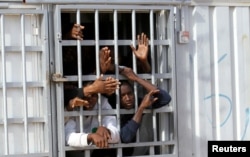Thousands of women and children who risk the dangerous central Mediterranean Sea crossing from North Africa to Italy to escape war and poverty are subjected to violence, sexual exploitation and other forms of abuse, according to a new report by the U.N. Children’s Fund.
A survey conducted late last year on conditions in Libya reveals what UNICEF describes as appalling levels of abuse along the migration route.
At that time, 256,000 migrants were recorded in Libya, including 30,803 women and more than 23,102 children. One third of the children in Libya were unaccompanied, although the real figures are believed to be at least three times higher.
Sexual, verbal abuse
“Nearly half of the women interviewed reported suffering sexual violations or abuse and most of the children and girls reported verbal or emotional abuse, and half had suffered physical beatings.” said Afshan Khan, UNICEF regional director and special coordinator for the refugee and migrant crisis in Europe.
“The women held in detention centers in western Libya reported very harsh conditions, poor nutrition and sanitation, overcrowding.”
Libya has an estimated 34 detention centers. Twenty-four of them are run by the Libyan Government Department for Combating Illegal Migration. The centers reportedly hold between 4,000 and 7,000 detainees.
The international community, including UNICEF, has access to less than half of the government-run centers. While they have no access to the militia-run detention centers, people who have been held there described them as “no more than forced labor camps, farms, warehouses and makeshift prisons run by armed groups.”
The UNICEF report said for the thousands of migrant women and children incarcerated in the militia-run centers, “they were living hellholes” where people were held for months at a time without any due process, “in squalid cramped conditions.”
Khan said most of the children and women interviewed for the survey last year said that “they expected to spend extended periods working in Libya to pay for the next leg of the journey.”
Smugglers charge anywhere between $100 and more than $2,100 for a sea crossing from Libya to Italy. Khan told VOA that once migrants “arrive in Libya, they are in the hands of often smugglers and these young people and children are treated as a commodity. They are not treated as people on a journey.”
She said that migrants do not pay all the money to the smugglers up front, but pay on certain legs of the trip.
“Now, again, the young girls I spoke to, many of them had gotten money for the initial leg and then were resorting to sex, transactional sex to pay for the rest of the legs going forward.”
She said, “So, these girls are particularly vulnerable. There is a lot of trafficking for sexual exploitation and abuse.“
Child prostitution
Khan said children, particularly young girls, often were brought to different countries as prostitutes by networks of criminal gangs. She noted that boys also were caught up in criminal networks and were forced to hustle on the streets or fall into prostitution.
In addition to the horrific experiences, the report noted that many children died along the dangerous migratory route from North Africa to Europe. Last year, more than 4,500 people perished crossing the Mediterranean Sea from Libya to Italy, including at least 700 children.
The stretch between the two countries has become the main crossing point for migrants seeking a better life in Europe.
Khan said that the desert crossing from Niger into Libya “is one of the most dangerous routes.”
She said, “Crossing the desert, the number of children, women, even adults that are dying are unknown to us. There are no protective measures along the way. There is no processing. So, once they arrive in Libya, it is chaotic.”
UNICEF reports children from Somalia, Ethiopia, Nigeria, Niger, Eritrea, and Gambia who are as young as 12 are traveling alone across the desert along the central Mediterranean route.
“The push factors range from conflict to lack of economic opportunities or jobs to early child marriage for some of the girls.
“What we are seeing here is, I would say, multiple push factors that are leading to a level of tragedy that we have not seen in this century, with respect to children on the move.”
She said, “This requires a response that is far more coordinated across national boundaries than we have seen to date.”








